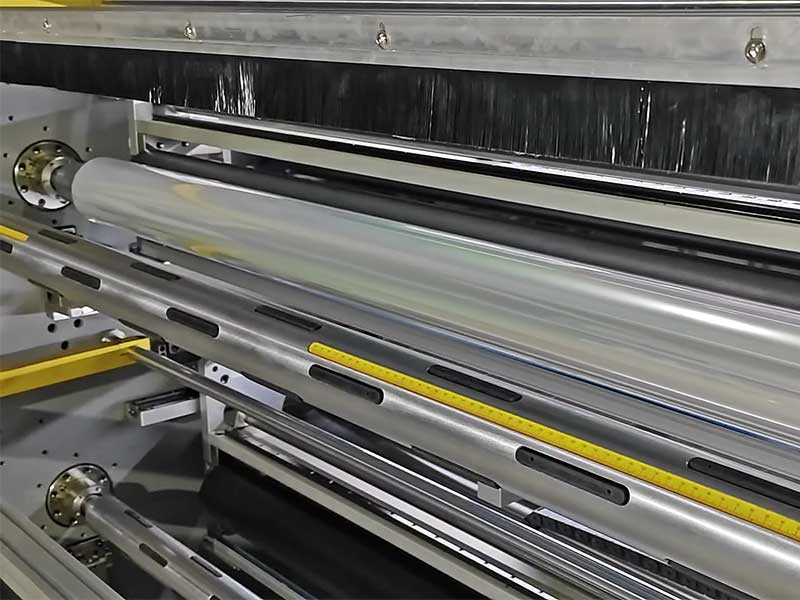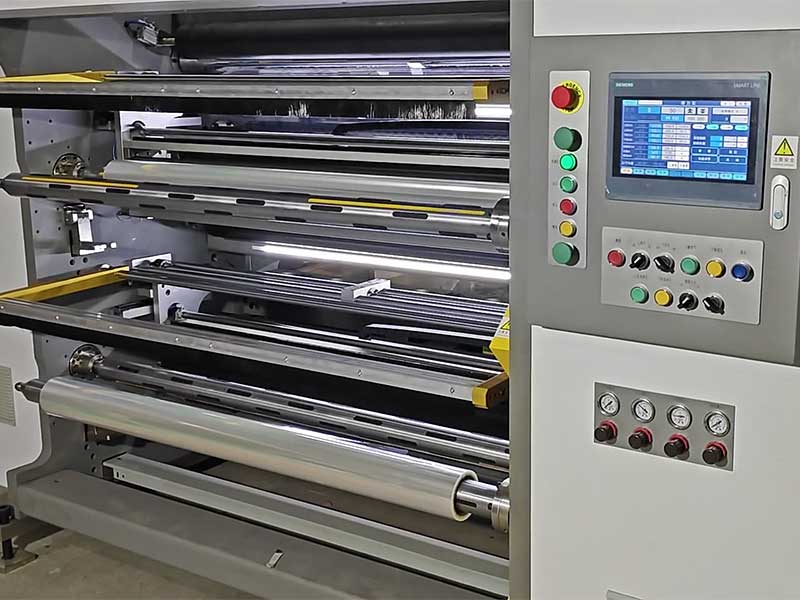In the grand automotive industry chain, our eyes are often attracted by vehicle assembly, engine technology or intelligent cockpits. However, in the automotive aftermarket at the end of the industrial chain, especially in the field of solar film production, there is a seemingly inconspicuous but crucial equipment - the automotive solar film slitting machine. It is like a silent "behind-the-scenes hero", accurately "breaking into pieces" of wide master rolls, which directly determines the quality, delivery speed and production cost of the end product. How does this small equipment play a key role as the "efficiency engine" of the production line?

1. From "bottleneck" to "hub": the core position of the slitting machine
In the production process of solar film, the pre-process such as coating and coating produces large coils of raw materials with a width of 1.5 meters to more than 3 meters. and the final application to the windows of thousands of cars is a specific size ranging from tens of centimeters to more than one meter. Slitting is the "last mile" connecting mass production and individual needs.
In the past, if the slitting process was inefficient and insufficient precision, it would become a "bottleneck" in the entire production process:
• Inefficiency: Slow manual or semi-automatic slitting speeds can lead to the accumulation of master rolls from the previous process, affecting overall production capacity.
• Poor accuracy: problems such as uneven slitting, burrs, and powder drops directly cause material waste and reduce yield rate.
• Insufficient flexibility: When switching between products with different specifications, the debugging time is long, and it is impossible to quickly respond to the diverse order needs of the market.
The introduction of modern high-precision automatic slitting machines has revolutionized this situation, elevating it from a potential "bottleneck" to an "efficiency hub" in the production line.

2. The four core driving forces of the "efficiency engine"
1. The perfect combination of extreme speed and precision
Modern slitting machines use a highly rigid body structure, servo motor drive, and precision transmission system to operate stably at speeds of up to hundreds of meters per minute. What's more, it can still ensure a slitting accuracy of ± 0.1 mm or more even at high speeds. This means that the edges of each roll of finished film are smooth and straight, without burrs and no overflow, ensuring the smoothness and final visual effect during film application, and improving product quality and brand image from the root.
2. Deep empowerment of intelligence and automation
• One-click setting: the operator only needs to enter the desired width, length and number of rolls on the touch screen, and the machine automatically adjusts all parameters.
• Automatic Deviation Correction (EPC): Highly sensitive sensors can track the edges of the membrane in real time and automatically correct deviations, ensuring that the slitting path is always straight and eliminating waste caused by offset.
• Automatic Shutdown for Fixed Length: Precise control of the length of each roll of finished film, enabling automated production and reducing manual intervention.
These intelligent functions greatly shorten the time for order change and debugging, reduce the dependence on operator skills, and realize the unity of "fool" operation and "expert-level" output.

3. The patron saint of "0 waste" of materials
Solar films, especially high-end magnetron sputter films and ceramic films, have high raw material costs. The accuracy of the slitting machine is directly linked to the profit margin. High-precision slitting minimizes offcuts waste during the cutting process. At the same time, the stable tension control system ensures that the film material does not wrinkle, stretch, or damage the functional coating during the slitting and winding process, pushing the yield rate to the extreme. Every inch of material saved is directly converted into the net profit of the enterprise.
4. Key pivot for production flexibility
The automotive sun film market has a wide range of specifications, from side windows, rear to front windows, with different sizes and shapes. A good slitting machine can easily and quickly switch between different specifications. Producing A4 paper-sized sample rolls today and switching to a 1.52-meter-wide panoramic sunroof film tomorrow can handle it calmly. This flexibility allows the production line to quickly respond to the market trend of "small batches, multiple batches", helping companies seize opportunities in the fierce competition.
3. Beyond "slitting": the ripple effect of the efficiency engine
The efficiency gains brought by slitting machines do not exist in isolation, and the "ripple effect" they produce runs through the entire operation chain:
• Warehouse optimization: On-demand slitting reduces the inventory occupation of finished films and enables leaner inventory management.
• Logistics efficiency: Slitted standard rolls are easier to pack, handle and transport, improving logistics efficiency.
• Manpower Liberation: Automated production frees workers from repetitive and heavy labor and shifts to higher-value tasks such as equipment maintenance and quality inspection.
epilogue
The automotive solar film slitting machine, this equipment standing in the corner of the production line, may not be good-looking, but it is a model of modern manufacturing "fighting big with small". Through extreme precision, intelligent automation, extreme respect for materials and unlimited flexibility, it transforms huge industrial master coils into precise dimensions that fit every car, driving the entire production process to run efficiently and with high quality.
It is not only a piece of equipment on the production line, but also a powerful "efficiency engine", silently injecting a steady stream of power into the competitiveness of the end product, proving that in the era of lean manufacturing, the real power is often hidden in those "key details" that make a single process the ultimate in it.
 Intelligent deviation correction: the "invisible guardian" of automotive film slitting machine
Intelligent deviation correction: the "invisible guardian" of automotive film slitting machine Film revolution: an intelligent cutting knife, how to cut out the new profit space of the automotive film industry?
Film revolution: an intelligent cutting knife, how to cut out the new profit space of the automotive film industry? Speed and precision go hand in hand: where is the performance limit of the solar film slitting machine?
Speed and precision go hand in hand: where is the performance limit of the solar film slitting machine? From coil to finished product: the value of solar film slitting machine is sublimated
From coil to finished product: the value of solar film slitting machine is sublimated The invisible champion of cost reduction and efficiency increase: solar film slitting machine
The invisible champion of cost reduction and efficiency increase: solar film slitting machine